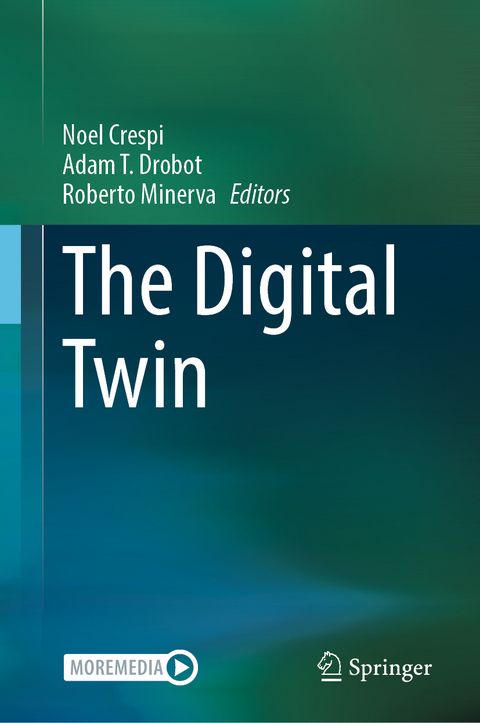
The Digital Twin
Springer International Publishing
978-3-031-21342-7 (ISBN)
Digital Twins are about creating faster, less expensive, and error-free manufacturing, products, processes, and services. This includes engineering of systems for energy, communications, construction, transportation, and food processing. It also covers solutions for making human existence better and more enjoyable through the life sciences, smart cities, and artistic creations. The Digital Twin's functionality addresses the entire lifecycle of products and services. Importantly, the book describes the journey required for businesses and public organizations to embrace Digital Twins as part of their tool kit.
The Digital Twin is the ideal starting point for teaching and research in all application domains.
lt;b>Prof. Noel Crespi holds Masters degrees from the Universities of Orsay (Paris 11) and Kent (UK), a diplome d'ingénieur from Telecom ParisTech, and a Ph.D and an Habilitation from UPMC (Paris-Sorbonne University). From 1993 he worked at CLIP, Bouygues Telecom and then at Orange Labs in 1995. He took leading roles in the creation of new services with the successful conception and launch of Orange prepaid service, and in standardization (from rapporteurship of the Intelligent Network standard to the coordination of all mobile standards activities for Orange). In 1999, he joined Nortel Networks as telephony program manager, architecting core network products for the EMEA region. He joined Institut Mines-Telecom SudParis in 2002 and is currently Professor and Program Director at Institut Polytechnique de Paris, leading the Service Architecture Lab. He coordinates the standardization activities for Institut Mines-Telecom at ITU-T and ETSI. He is also an adjunct professor at KAIST (South Korea), an affiliate professor at Concordia University (Canada), and a guest researcher at the University of Goettingen (Germany). He is the scientific director of ILLUMINE, a French-Korean laboratory. His current research interests are in Data Analytics, the Internet of Things and Softwarization.
Dr. Adam T. Drobot is an experienced technologist and manager. His activities are strategic consulting, start-ups, and industry associations. He is the Chairman of the Board of OpenTechWorks, Inc and serves on the boards of multiple companies and no-profit organizations. In the past he was the Managing Director and CTO of 2M Companies, the President of Applied Technology Solutions and the CTO of Telcordia Technologies (Bellcore). Previous to that, he managed the Advanced Technology Group at Science Applications International (SAIC/Leidos) and was the Senior Vice President for Science and Technology at SAIC.
He is a member of the FCC Technological Advisory Council. In the past he was on the Board of the Telecommunications Industry Association where he Chaired the Technology Committee; the US Department of Transportation Intelligent Transportation Systems Program Advisory Committee; and the University of Michigan Transportation Research Institute External Advisory Board. In 2017 and 2018 he chaired the IEEE Internet of Things Initiative Activities Board. He has published over 100 journal articles and holds 27 patents. In his professional career he was responsible for the development of several major multi-disciplinary scientific modeling codes and specialized in developing tools and techniques for the design, management, and operation of complex scientific facilities, discrete manufacturing systems, and large-scale platforms, for government and industry. His degrees include a BA in Engineering Physics from Cornell University and a PhD. in Plasma Physics from the University of Texas at Austin.
Dr. Roberto Minerva (Senior Member, IEEE) received the M.S. degree (summa cum laude) in computer science from the University of Bari Aldo Moro, Bari, Italy, in 1987, and the Ph.D. degree in computer science and telecommunications from Pierre and Marie Curie University-Sorbonne University, Paris, France, in 2013. From 1987 to 1996, he was a Researcher in the area of service architectures and network intelligence with the Telecom Italia Research Center. In the following years, he was responsible for several research groups related to network intelligence and evolution to next generation networks. From 2013 to 2016, he was appointed to the Strategic Initiatives of TIM. Since 2016, he has been the Technical Project Leader of the SoftFIRE, a European Project devoted to the experimentation of network function virtualization (NFV), software defined networking (SDN), and edge computing. Since 2018, he has been an Associate Professor in softwarization with the Service Architecture
Part I. The Landscape, Implications, and Assumptions.- Chap 1. The Digital Twin: Why and What?.- Chap 2. DT and Digital Revolution.- Chap 3. Business models design for the Digital Twin.- Chap 4. The evolution and history of the Digital Twin.- Part II. Technologies.- Chap 5. Representing the DT: New devices, new interfaces.- Chap 6. Where the data come from? Relation between IoT and DT.- Chap 7. AI for DT: from data to knowledge.- Chap 8. Simulation.- Chap 9. Architectures and Implementations.- Chap 10. Network for Digital Twin.- Chap 11. Managing the unmanageable.- Chap 12. Security and DT.- Section III The Digital Twin in Operation.- Chap 13. Making the DT Operational in Enterprise Processes.- Chap 14. Making the DT Operational in a Large Ecosystem.- Section IV Vertical Domains for Digital Twin Applications.- Chap 15. The Digital Twin in Manufacturing.- Chap 16. The Digital Twin for Operations, Maintenance, Repair, and Overhaul.- Chap 17. The Digital Twin for Display, Education, and Curation.- Chap 18. Prognostication and Prediction, Prevention, and Prescription.- Chap 19. The Digital Twin in Human Activities and Nature: the eHealth example.- Chap 20. The Digital Twin in Complex Systems.- Section V Conclusion.- Chap 21. Future Evolution of the Digital Twin.- Chap 22. DT in Action and lesson learnt.
| Erscheint lt. Verlag | 3.6.2023 |
|---|---|
| Zusatzinfo | XII, 1238 p. 150 illus., 132 illus. in color. In 2 volumes, not available separately. |
| Verlagsort | Cham |
| Sprache | englisch |
| Maße | 155 x 235 mm |
| Gewicht | 2576 g |
| Themenwelt | Technik ► Elektrotechnik / Energietechnik |
| Schlagworte | Artificial Intelligence • Big Data Analytics • business process management • computation by abstract devices • computer-aided engineering and design • Computer Communication Networks • Control and Systems Theory • Digital Revolution • Engineering Economics • Enterprise Architecture • Information Systems and Communication Service • Innovation/Technology Management • machine learning • Manufacturing Organization • Mathematics of Computing • Models and Principles • Multimedia Information Systems • Operations Management • Simulation and modeling |
| ISBN-10 | 3-031-21342-4 / 3031213424 |
| ISBN-13 | 978-3-031-21342-7 / 9783031213427 |
| Zustand | Neuware |
| Haben Sie eine Frage zum Produkt? |
aus dem Bereich


